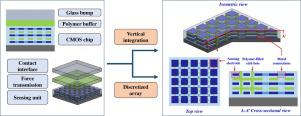Sensors and Actuators A: Physical ( IF 4.1 ) Pub Date : 2020-11-24 , DOI: 10.1016/j.sna.2020.112350 Meng-Lin Hsieh , Sheng-Kai Yeh , Jia-Horng Lee , Ming-Ching Cheng , Weileun Fang

|
This study presents the design, fabrication, and testing of a novel capacitive type CMOS-MEMS tactile sensor with vertically integrated sensing structures for enhancing sensitivity, and discretized sensing array design for inhibiting residual stress warpage. The proposed type tactile sensor utilizes polymer buffer above the sensor and polymer fill-in between the vertically integrated sensing structures as force transmission layers. This enables effective force loading onto the sensor, and more importantly, simultaneous deformation of the two vertically integrated sensing structures during force loading, thereby guaranteeing an increase in sensitivity. The enhancement in sensitivity of the proposed tactile sensor was demonstrated to be achieved under the same footprint area. To mitigate warpage issues that may occur due to thin film residual stresses, the sensor was discretized into arrays of separate sensing units. Sensing units are electrically connected in a parallel fashion to ensure maximum capacitance signal. As compared to a reference tactile sensor with conventional sensing electrodes, the proposed design showed a near 1.3-fold enhancement in sensitivity. Measurements also indicate the 5 × 5 array design could tolerate the influence of residual stress. Additionally, effect of operating temperature on initial capacitance (temperature coefficient of offset, TCO) and capacitance change signal during force loadings (temperature coefficient of sensitivity, TCS) were investigated for both the reference and proposed type tactile sensors.
中文翻译:

具有垂直集成感应电极阵列的CMOS-MEMS电容式触觉传感器,可增强灵敏度
这项研究提出了一种新型电容式CMOS-MEMS触觉传感器的设计,制造和测试,该传感器具有垂直集成的传感结构以增强灵敏度,并采用离散化的传感阵列设计来抑制残余应力翘曲。所提出的类型的触觉传感器利用传感器上方的聚合物缓冲器和垂直整合的传感结构之间的聚合物填充物作为力传递层。这使得能够有效地将力加载到传感器上,并且更重要的是,在力加载期间两个垂直集成的传感结构同时变形,从而确保了灵敏度的提高。事实证明,所提出的触觉传感器的灵敏度提高是在相同的覆盖面积下实现的。为了减轻可能由于薄膜残余应力而引起的翘曲问题,将传感器离散化为独立传感单元的阵列。传感单元以并联方式电连接,以确保最大的电容信号。与具有常规感测电极的参考触觉传感器相比,所提出的设计显示出灵敏度提高了近1.3倍。测量还表明5×5阵列设计可以承受残余应力的影响。另外,针对参考型和拟议类型的触觉传感器,研究了工作温度对初始电容(偏移温度系数,TCO)和力负载期间电容变化信号(灵敏度温度系数,TCS)的影响。传感单元以并联方式电连接,以确保最大的电容信号。与具有常规感测电极的参考触觉传感器相比,所提出的设计显示出灵敏度提高了近1.3倍。测量还表明5×5阵列设计可以承受残余应力的影响。另外,针对参考型和拟议类型的触觉传感器,研究了工作温度对初始电容(偏移温度系数,TCO)和力负载期间电容变化信号(灵敏度温度系数,TCS)的影响。传感单元以并联方式电连接,以确保最大的电容信号。与具有常规感测电极的参考触觉传感器相比,所提出的设计显示出灵敏度提高了近1.3倍。测量还表明5×5阵列设计可以承受残余应力的影响。另外,针对参考型和拟议类型的触觉传感器,研究了工作温度对初始电容(偏移温度系数,TCO)和力负载期间电容变化信号(灵敏度温度系数,TCS)的影响。灵敏度提高3倍。测量还表明5×5阵列设计可以承受残余应力的影响。另外,针对参考型和拟议类型的触觉传感器,研究了工作温度对初始电容(偏移温度系数,TCO)和力负载期间电容变化信号(灵敏度温度系数,TCS)的影响。灵敏度提高3倍。测量还表明5×5阵列设计可以承受残余应力的影响。另外,针对参考型和拟议类型的触觉传感器,研究了工作温度对初始电容(偏移温度系数,TCO)和力负载期间电容变化信号(灵敏度温度系数,TCS)的影响。











































 京公网安备 11010802027423号
京公网安备 11010802027423号